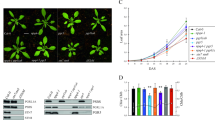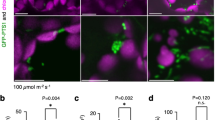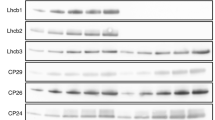Abstract
When plants are exposed to light levels higher than those required for photosynthesis, reactive oxygen species are generated in the chloroplasts and cause photodamage. This can occur even under natural growth conditions. To mitigate photodamage, plants have developed several protective mechanisms1,2,3. One is chloroplast avoidance movement4,5,6, in which chloroplasts move from the cell surface to the side walls of cells under high light conditions, although experimental support is still awaited7,8. Here, using different classes of mutant defective in chloroplast avoidance movement, we show that these mutants are more susceptible to damage in high light than wild-type plants. Damage of the photosynthetic apparatus and subsequent bleaching of leaf colour and necrosis occur faster under high light conditions in the mutants than in wild-type plants. We conclude that chloroplast avoidance movement actually decreases the amount of light absorption by chloroplasts, and might therefore be important to the survival of plants under natural growth conditions.
This is a preview of subscription content, access via your institution
Access options
Subscribe to this journal
Receive 51 print issues and online access
$199.00 per year
only $3.90 per issue
Buy this article
- Purchase on Springer Link
- Instant access to full article PDF
Prices may be subject to local taxes which are calculated during checkout



Similar content being viewed by others
References
Asada, K. The water-water cycle in chloroplasts: scavenging of active oxygens and dissipation of excess photons. Annu. Rev. Plant Physiol. Plant Mol. Biol. 50, 601–639 (1999)
Niyogi, K. K. Photoprotection revisited: genetic and molecular approaches. Annu. Rev. Plant Physiol. Plant Mol. Biol. 50, 333–359 (1999)
Demmig-Adams, B. & Adams, W. W. III Photoprotection and other responses of plants to high light stress. Annu. Rev. Plant Physiol. Plant Mol. Biol. 43, 599–626 (1992)
Wada, M. & Kagawa, T. Photomovement (eds Häder, D.-P. & Lebert, M.) 897–924 (Elsevier, Amsterdam, 2001)
Haupt, W. & Scheuerlein, R. Chloroplast movement. Plant Cell Environ. 13, 595–614 (1990)
Zurzycki, J. The Blue Light Syndrome (ed. Senger, H.) 50–68 (Springer, Berlin, 1980)
Brugnoli, E. & Björkman, O. Chloroplast movements in leaves: influence on chlorophyll fluorescence and measurements of light-induced absorbance changes related to ΔpH and zeaxanthin formation. Photosynth. Res. 32, 23–35 (1992)
Park, Y.-I., Chow, W. S. & Anderson, J. M. Chloroplast movement in the shade plant Tradescantia albiflora helps protect photosystem II against light stress. Plant Physiol. 111, 867–875 (1996)
Trojan, A. & Gabrys, H. Chloroplast distribution in Arabidopsis thaliana (L.) depends on light conditions during growth. Plant Physiol. 111, 419–425 (1996)
Kagawa, T. et al. Arabidopsis NPL1: a phototropin homolog controlling the chloroplast high-light avoidance response. Science 291, 2138–2141 (2001)
Sakai, T. et al. Arabidopsis nph1 and npl1: blue light receptors that mediate both phototropism and chloroplast relocation. Proc. Natl Acad. Sci. USA 98, 6969–6974 (2001)
Jarillo, J. A. et al. Phototropin-related NPL1 controls chloroplast relocation induced by blue light. Nature 410, 952–954 (2001)
Kadota, A. & Wada, M. Photoorientation of chloroplasts in protonemal cells of the fern Adiantum as analyzed by use of a video-tracking system. Bot. Mag. Tokyo 105, 265–279 (1992)
Tlalka, M. & Gabrys, H. Influence of calcium on blue-light-induced chloroplast movement in Lemna trisulca L. Planta 189, 491–498 (1993)
Powles, S. B. Photoinhibition of photosynthesis induced by visible light. Annu. Rev. Plant Physiol. 35, 15–44 (1984)
Barber, J. & Andersson, B. Too much of a good thing: light can be bad for photosynthesis. Trends Biochem. Sci. 17, 61–66 (1992)
Björkman, O. & Demmig, B. Photon yield of O2 evolution and chlorophyll fluorescence characteristics at 77 K among vascular plants of diverse origins. Planta 170, 489–504 (1987)
Miyagawa, Y., Tamoi, M. & Shigeoka, S. Evaluation of the defense system in chloroplasts to photooxidative stress caused by paraquat using transgenic tobacco plants expressing catalase from Escherichia coli. Plant Cell Physiol. 41, 311–320 (2000)
Kinoshita, T. et al. phot1 and phot2 mediate blue light regulation of stomatal opening. Nature 414, 656–660 (2001)
Escoubas, J. M., Lomas, M., LaRoche, J. & Falkowski, P. G. Light intensity regulation of cab gene transcription is signaled by the redox state of the plastoquinone pool. Proc. Natl Acad. Sci. USA 92, 10237–10241 (1995)
Sukenik, A., Wyman, K. D., Bennett, J. & Falkowski, P. G. A novel mechanism for regulating the excitation of photosystem II in a green alga. Nature 327, 704–707 (1987)
Haughn, G. W. & Somerville, C. Sulfonylurea-resistant mutants of Arabidopsis thaliana. Mol. Gen. Genet. 204, 430–434 (1986)
Acknowledgements
We thank J. Silverthorne (University of California, Santa Cruz) and S. Christensen (Tokyo Metropolitan University) for critical reading of the manuscript, and N. Murata (National Institute for Basic Biology, Japan) for use of the PAM-2000 system. This work was partly supported by BRAIN (Program for Promotion of Basic Research Activities for Innovative Biosciences) and a Grant-in-Aid for Scientific Research from the Ministry of Education, Sports, Science and Technology (MEXT) of Japan to M.W., and by PRESTO, Japan Science and Technology Corporation, Japan, to T.K.
Author information
Authors and Affiliations
Corresponding author
Ethics declarations
Competing interests
The authors declare that they have no competing financial interests.
Rights and permissions
About this article
Cite this article
Kasahara, M., Kagawa, T., Oikawa, K. et al. Chloroplast avoidance movement reduces photodamage in plants. Nature 420, 829–832 (2002). https://doi.org/10.1038/nature01213
Received:
Accepted:
Issue Date:
DOI: https://doi.org/10.1038/nature01213
This article is cited by
-
Chloroplast-actin filaments decide the direction of chloroplast avoidance movement under strong light in Arabidopsis thaliana
Journal of Plant Research (2024)
-
Functional traits: the pathways to riverine plant resistance in times of hydropeaking
Ecological Processes (2023)
-
Statistical analysis of organelle movement using state-space models
Plant Methods (2023)
-
Differences in pigment circadian rhythmicity in green- and red-leafed tree species in the sun and shade
Journal of Forestry Research (2023)
-
Strigolactones Stimulate High Light Stress Adaptation by Modulating Photosynthesis Rate in Arabidopsis
Journal of Plant Growth Regulation (2023)
Comments
By submitting a comment you agree to abide by our Terms and Community Guidelines. If you find something abusive or that does not comply with our terms or guidelines please flag it as inappropriate.



